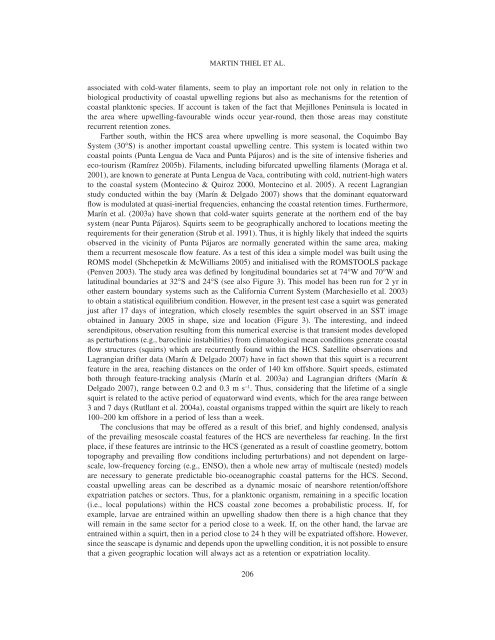the humboldt current system of northern and central chile - figema
the humboldt current system of northern and central chile - figema
the humboldt current system of northern and central chile - figema
Create successful ePaper yourself
Turn your PDF publications into a flip-book with our unique Google optimized e-Paper software.
MARTIN THIEL ET AL.associated with cold-water filaments, seem to play an important role not only in relation to <strong>the</strong>biological productivity <strong>of</strong> coastal upwelling regions but also as mechanisms for <strong>the</strong> retention <strong>of</strong>coastal planktonic species. If account is taken <strong>of</strong> <strong>the</strong> fact that Mejillones Peninsula is located in<strong>the</strong> area where upwelling-favourable winds occur year-round, <strong>the</strong>n those areas may constitutere<strong>current</strong> retention zones.Far<strong>the</strong>r south, within <strong>the</strong> HCS area where upwelling is more seasonal, <strong>the</strong> Coquimbo BaySystem (30°S) is ano<strong>the</strong>r important coastal upwelling centre. This <strong>system</strong> is located within twocoastal points (Punta Lengua de Vaca <strong>and</strong> Punta Pájaros) <strong>and</strong> is <strong>the</strong> site <strong>of</strong> intensive fisheries <strong>and</strong>eco-tourism (Ramírez 2005b). Filaments, including bifurcated upwelling filaments (Moraga et al.2001), are known to generate at Punta Lengua de Vaca, contributing with cold, nutrient-high watersto <strong>the</strong> coastal <strong>system</strong> (Montecino & Quiroz 2000, Montecino et al. 2005). A recent Lagrangianstudy conducted within <strong>the</strong> bay (Marín & Delgado 2007) shows that <strong>the</strong> dominant equatorwardflow is modulated at quasi-inertial frequencies, enhancing <strong>the</strong> coastal retention times. Fur<strong>the</strong>rmore,Marín et al. (2003a) have shown that cold-water squirts generate at <strong>the</strong> nor<strong>the</strong>rn end <strong>of</strong> <strong>the</strong> bay<strong>system</strong> (near Punta Pájaros). Squirts seem to be geographically anchored to locations meeting <strong>the</strong>requirements for <strong>the</strong>ir generation (Strub et al. 1991). Thus, it is highly likely that indeed <strong>the</strong> squirtsobserved in <strong>the</strong> vicinity <strong>of</strong> Punta Pájaros are normally generated within <strong>the</strong> same area, making<strong>the</strong>m a re<strong>current</strong> mesoscale flow feature. As a test <strong>of</strong> this idea a simple model was built using <strong>the</strong>ROMS model (Shchepetkin & McWilliams 2005) <strong>and</strong> initialised with <strong>the</strong> ROMSTOOLS package(Penven 2003). The study area was defined by longitudinal boundaries set at 74°W <strong>and</strong> 70°W <strong>and</strong>latitudinal boundaries at 32°S <strong>and</strong> 24°S (see also Figure 3). This model has been run for 2 yr ino<strong>the</strong>r eastern boundary <strong>system</strong>s such as <strong>the</strong> California Current System (Marchesiello et al. 2003)to obtain a statistical equilibrium condition. However, in <strong>the</strong> present test case a squirt was generatedjust after 17 days <strong>of</strong> integration, which closely resembles <strong>the</strong> squirt observed in an SST imageobtained in January 2005 in shape, size <strong>and</strong> location (Figure 3). The interesting, <strong>and</strong> indeedserendipitous, observation resulting from this numerical exercise is that transient modes developedas perturbations (e.g., baroclinic instabilities) from climatological mean conditions generate coastalflow structures (squirts) which are re<strong>current</strong>ly found within <strong>the</strong> HCS. Satellite observations <strong>and</strong>Lagrangian drifter data (Marín & Delgado 2007) have in fact shown that this squirt is a re<strong>current</strong>feature in <strong>the</strong> area, reaching distances on <strong>the</strong> order <strong>of</strong> 140 km <strong>of</strong>fshore. Squirt speeds, estimatedboth through feature-tracking analysis (Marín et al. 2003a) <strong>and</strong> Lagrangian drifters (Marín &Delgado 2007), range between 0.2 <strong>and</strong> 0.3 m s −1 . Thus, considering that <strong>the</strong> lifetime <strong>of</strong> a singlesquirt is related to <strong>the</strong> active period <strong>of</strong> equatorward wind events, which for <strong>the</strong> area range between3 <strong>and</strong> 7 days (Rutllant et al. 2004a), coastal organisms trapped within <strong>the</strong> squirt are likely to reach100–200 km <strong>of</strong>fshore in a period <strong>of</strong> less than a week.The conclusions that may be <strong>of</strong>fered as a result <strong>of</strong> this brief, <strong>and</strong> highly condensed, analysis<strong>of</strong> <strong>the</strong> prevailing mesoscale coastal features <strong>of</strong> <strong>the</strong> HCS are never<strong>the</strong>less far reaching. In <strong>the</strong> firstplace, if <strong>the</strong>se features are intrinsic to <strong>the</strong> HCS (generated as a result <strong>of</strong> coastline geometry, bottomtopography <strong>and</strong> prevailing flow conditions including perturbations) <strong>and</strong> not dependent on largescale,low-frequency forcing (e.g., ENSO), <strong>the</strong>n a whole new array <strong>of</strong> multiscale (nested) modelsare necessary to generate predictable bio-oceanographic coastal patterns for <strong>the</strong> HCS. Second,coastal upwelling areas can be described as a dynamic mosaic <strong>of</strong> nearshore retention/<strong>of</strong>fshoreexpatriation patches or sectors. Thus, for a planktonic organism, remaining in a specific location(i.e., local populations) within <strong>the</strong> HCS coastal zone becomes a probabilistic process. If, forexample, larvae are entrained within an upwelling shadow <strong>the</strong>n <strong>the</strong>re is a high chance that <strong>the</strong>ywill remain in <strong>the</strong> same sector for a period close to a week. If, on <strong>the</strong> o<strong>the</strong>r h<strong>and</strong>, <strong>the</strong> larvae areentrained within a squirt, <strong>the</strong>n in a period close to 24 h <strong>the</strong>y will be expatriated <strong>of</strong>fshore. However,since <strong>the</strong> seascape is dynamic <strong>and</strong> depends upon <strong>the</strong> upwelling condition, it is not possible to ensurethat a given geographic location will always act as a retention or expatriation locality.206










